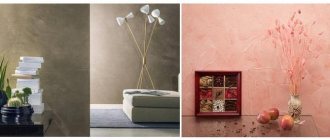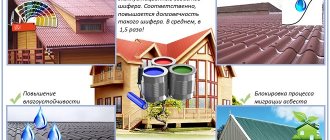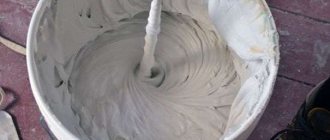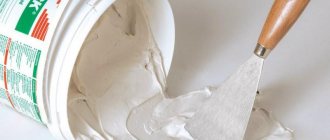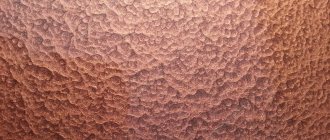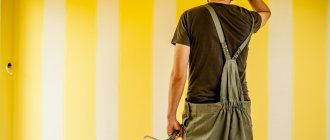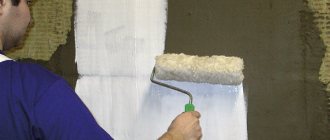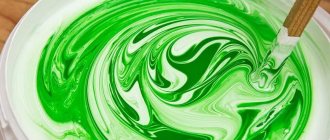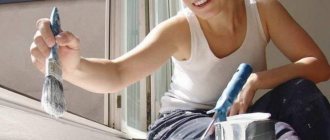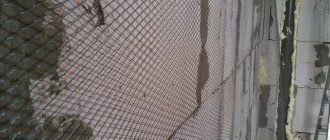Polymer paints have become widespread. Their demand is explained by the large assortment, ease of use and aesthetics of the resulting coating. Information about latex or acrylic paint – which is better and what is the difference between the compositions – will help you choose the appropriate option.
Find out if latex paint is better.
What components does the paint consist of?
Water soluble paint
The composition of all water-soluble rubber-based paints is identical and includes:
- The binder is one polymer or a mixture of several that make up the base. They provide surface adhesion, durability and resistance to negative impacts.
- Pigment is a powdery substance in the form of a suspension that gives color to the composition.
- Filler - has a structure similar to pigment, but its molecules are larger. Responsible for such properties of the finishing material as dullness or glossy shine, and also enhances the durability of the coloring matter
- Solvent (or water) - a liquid in which coloring particles are distributed
- Additional components - additives that impart new physical and chemical properties and improve the properties of latex
Latex paint samples
When applied to a surface, the liquid evaporates after some time. Particles of polymer and coloring pigment are combined to form a film that is elastic and durable.
The aqueous dispersion phase of all latex paints consists of synthetic rubber particles stabilized by emulsifiers, which can be:
- acrylic
- urethane
- siloxane
- polyvinyl acetate
- butadiene-styrene
Which paint to choose?
Acrylic latex is considered the best, but also the most expensive. Acrylic with an admixture of latex is slightly inferior in quality, but also more accessible. If the budget is limited or high quality requirements are not imposed on the surface to be painted, the choice comes down to materials belonging to the cheaper latex paintwork materials:
- Polyvinyl acetate . Cheap PVA-based paint with good adhesion to the surface. Its disadvantage is that it gets dirty and is washed off after drying, does not tolerate low temperatures, and can only be used in heated and dry rooms.
- Butadiene-styrene . They have a slightly higher cost, but are resistant to moisture. The disadvantage is that they quickly fade under the influence of ultraviolet radiation, so they are intended for rooms with a low degree of natural light.
- Acrylic silicone . The best choice for painting facades. This type of paintwork material is wear-resistant, moisture-resistant, vapor-permeable, and is not afraid of direct sunlight, but it is also more expensive than the first two options.
In other words, the main criterion is what surfaces are planned to be painted.
Latex paint and its types
Styrene-butadiene emulsion
The binding element in latex dyes is synthetic rubber based on copolymers.
It gives the raw materials for dyeing the following characteristics:
- Resistant to stains and repels dust particles
- Quick drying on surface
- The ability to evaporate moisture from the painted area due to the fact that the latex layer allows oxygen to pass through
- The saturation of pigments, which makes the color of such paints brighter
- No toxic components (allowed to be used for interior decoration)
- Elasticity, modeling a flat surface by filling all unevenness and roughness
- Economy in use
Latex paint
The types of paints and varnishes, depending on the components in the composition, are presented in the table.
| View | Characteristics | Which finish is it suitable for? |
| Polyvinyl acetate (water-based or water-dispersed) | Made from PVA glue, non-toxic, provides good adhesion to the surface. Disadvantages: unstable, easily washed off with water | For dry rooms |
| Butadiene-styrene | Resistant to water, but fades easily in sunlight | For bathrooms, toilets, corridors, basements |
| Acrylic | High-quality, suitable for interior work, facade finishing and painting exterior elements | For interior and exterior decoration |
| Acrylic-silicone | Reliable facade finishing with high durability | For facades and rooms with high humidity |
| Washable | Based on an acrylate binder polymer | For interior work |
| Rubber acrylate-latex | Creates a coating that is resistant to moisture, UV radiation, and temperature fluctuations, elastic and quick-drying. | For covering tennis courts, swimming pools, running tracks |
For interior work the following are most often used:
- vinyl
- acrylic
- dripless
- textured
- dense
Latex finishing compounds can give different finishing effects: matte, glossy or semi-matte.
Latex materials used:
- For external work (painting facades)
- For interior decoration (for walls and ceilings)
- For painting the floor
- For surface waterproofing
- Universal
What and in what case is it better to choose
Based on the strengths and weaknesses of the paints being compared, as well as the result of contrasting their main characteristics, we can give some advice on what is best to choose and in what case.
Acrylic. The paint is a universal type. Therefore, it can be used without restrictions both indoors and outdoors. In the presence of special stabilizers, it can be used for painting walls and ceilings in damp rooms, such as the kitchen and bathroom. You can find out about the level of water resistance on the packaging.
Latex. Paint based on the styrene-butadiene group is not a universal type of dye. Therefore, its use is limited to the interior of an apartment or house. In addition, there are restrictions on rooms with high humidity and sudden temperature changes. For example, windows in rooms should not be opened wide in winter, as the paint layer may crack and fall off.
At the same time, such characteristics of paint as lower price, ability to set faster and better appearance give it advantages when choosing paint for walls, especially for the north side of the apartment (paint on the south side fades in the sun).
For the corridor, hallway and closet it is also better to choose latex paint. In terms of its consumer characteristics, it is in no way inferior to acrylic paint, but it costs less.
If you want to save money, you can mix latex and acrylic paints in approximately equal proportions and paint the entire apartment, with the exception of the bathroom and the “apron” with the ceiling in the kitchen. However, it should be remembered that neither pure latex nor a mixture with acrylic paint is categorically suitable for outdoor work and unheated premises (dacha).
Acrylic paint and its types
Acrylic coatings
The binders that underlie acrylic paint are acrylic copolymers: silicone, vinyl, styrene. Manufacturers usually write this on the packaging – 100% acrylic.
Characteristics of paint based on acrylic polymer:
- elasticity
- high adhesion (adhesion to the surface)
- vapor permeability
- resistance to water and UV radiation
- range of colors up to 5 thousand shades
- paint brightness and durability
- safety of use (contains no toxic substances or heavy metal salts)
This coating does not crack due to sudden temperature fluctuations or abnormal temperatures, is easy to use and is used for most painting jobs. Acrylic films do not protect against fire. [/wpsm_box]
Painting with latex paint
There are the following types of acrylic finishes:
- glossy (dissolves under the influence of ordinary water)
- glyphthalic (contains acrylic resin, used for finishing residential premises)
- special (does not require preliminary priming, anti-corrosion, most expensive)
Can be applied to surfaces from:
- concrete
- glass
- metal
- stone
- bricks
- wood (fibreboard, MDF, chipboard)
- plaster
Advantages and disadvantages
Water-based paints have their strengths and weaknesses. But since we are talking about comparing paints within the same type, it is not advisable to dwell on this. Therefore, we will consider the pros and cons of acrylic and latex paint separately.
Latex paint
A water-based emulsion based on styrene-butadiene polymers has quite a few advantages:
- long service life. However, with a caveat, since in places exposed to sunlight it quickly fades, and therefore durability can only be discussed in rooms without ultraviolet rays: corridor, hallway, storage room;
- high level of wear resistance, which makes it possible to paint not only the ceiling, but also the walls;
- lower price among all types of water-based paint;
- increased moisture resistance, which allows for wet cleaning. However, this does not mean that such paint can be washed frequently and used to paint the ceiling and walls in the bathroom;
- good elasticity - a layer of paint hides minor defects in the surface of the walls (ceiling) well. The same property works well when painting wallpaper;
- more attractive appearance of the painted surface - silkiness appears;
- absence of a wet smell during application, which is observed with acrylic analogues;
- good adhesion to all types of wall materials, including porous ones.
Flaws:
- fades under UV rays;
- is afraid of sudden temperature changes, and therefore cannot be used as façade paint;
- serves as a good nutritional base for the growth of fungus and mold, which requires mandatory priming of the surface before painting with the addition of antiseptic materials.
Attention: latex paints have recently appeared on sale for facade work, where the main binder, styrene-butadiene, is scarce.
Acrylic paints
Acrylic paints have typical strengths and weaknesses for latex paints. Pros:
- durability;
- excellent adhesion to all types of building materials;
- elasticity;
- UV resistance;
- the widest range of colors (up to 5 thousand);
- does not become covered with a network of wrinkles during temperature fluctuations;
- tolerates frosts down to -40oC (with the addition of special fillers, the indicator drops to -60oC) - the facade can be painted;
- resistance against fungus;
- high level of vapor permeability - the walls “breathe” under the paint.
The disadvantages include:
- quite high price;
- presence of odor (disappears immediately after the walls dry).
What is the difference between acrylic and latex paints
Acrylic paints
Strictly speaking, it is impossible to draw a clear line between the two acrylic and latex paints: they have similar compositions. At its core, the first is a variety of the second: acrylic is a type of latex.
It is almost impossible to distinguish the two compositions visually. The difference is visible only during use or after reading the information about the composition on the package.
Both acrylic and latex paints have the following general characteristics:
- durability of use
- they can be applied to any coating, regardless of the relief
- durability and resistance to moisture
- UV resistance
- allow air to pass through (there will be no bubbles during application)
- harmless water acts as a solvent
- impart a silky texture to the painted surface
- non-toxic
However, latex paints due to the styrene-butadiene dispersion:
- They have greater elasticity, so they can be used for painting wallpaper.
- Visually give painted surfaces a more attractive appearance
- Can easily tolerate wet cleaning or other exposure to water
Interior acrylic paint
Acrylic paints are more expensive, but they also last longer and are more durable. Latex paints are best used for interior work in dry rooms without bright lighting; for exterior work it is best to use latex-based acrylic paints.
The difference between the two compositions can be most clearly seen by comparing water-based and acrylic paints. The former are optimally suited for indoor dry spaces, while the latter can be used anywhere and are not afraid of moisture.
Sellers of paint and varnish materials often offer customers an acrylic-latex mixture. It is cheaper than pure acrylic because it contains styrene-butadiene emulsion.
According to quality and physico-chemical characteristics, rubber paints are distributed from the best down in descending order as follows:
- Acrylic latex
- Acrylic-latex mixture
- Polyvinyl acetate
- Butadiene-styrene
- Acrylic silicone
The main differences between paintwork materials
There are certain differences between acrylic and latex materials. Thus, acrylic substances are often called more durable and of higher quality compared to latex ones. At the same time, they cost more. However, in reality, the properties of the materials are largely the same.
See also
How to pour paint on a car to remove paint and 14 substances that corrode it
By composition and properties
Previously, paints had significant differences in composition. Although both types of materials were made from water, acrylic dyes used acrylic resin as a binder, while latex dyes used latex or milk from the rubber tree.
Today, almost all manufacturers have eliminated the use of natural latex. Therefore, dyes, which are called latex, contain artificial thermoplastic resins, reminiscent of acrylic materials. As a result, the properties of the paints largely coincide. The coatings are washable and breathable. At the same time, there are a number of differences.
By purpose
Acrylic paint has a wide range of applications. It can be used without restrictions. The composition is applied to any materials and used in different places, including the exterior of buildings. At the same time, latex substances are prohibited from being used for façade work.
Also, they should not be applied in rooms with high humidity.
In terms of resistance and durability of the coating
The durability of the coating is influenced by a number of factors:
- wear resistance;
- UV resistance;
- resistance to high humidity.
If you focus on ideal operating conditions, both types of dyes differ in approximately the same performance. They are about 20 years old. However, in practice, acrylic coatings are more durable. Latex substances do not withstand exposure to the sun and high humidity.
Covering power
This term refers to the ability of a dye to cover the original shade of a surface. To indicate this parameter, a scale from 1 to 5 is used. The specific indicator depends on the ratio between binders and pigment. It is also affected by the size and number of particles.
Expert opinion
Zakharova Irina Yurievna
Cleaning professional with 15 years of experience. Our best expert.
Ask a Question
The higher the hiding power, the less paint you need to spend. This means that it is possible to purchase a more expensive material with high coverage parameters and at the same time save money on the number of layers.
Acrylic and latex dyes are often classified as opacity class 2. However, some European companies also offer Class 1 substances. Such materials allow you to get by with applying 1 layer of paint.
Moisture resistance and fading
Paints differ in moisture resistance parameters. The surface with latex material can be wiped with a damp cloth. In this case, the acrylic substance can be applied in rooms with high humidity.
Resistance to fading also has certain differences. Latex substances are afraid of ultraviolet radiation. They fade quickly when exposed to sunlight. Acrylic paints can be left in open areas for 10 years. At the same time, they will not lose their original shade.
See also
What colors to mix to get brown and its shades
For safety of use
Modern dyes are considered harmless. However, both acrylic and latex materials contain chemical components. Therefore, when using them, it is important to adhere to basic safety rules and use personal protective equipment. This will help avoid negative health consequences.
Cost and material consumption per 1 square meter
Latex dyes made from styrene-butadiene copolymers are cheaper than acrylic materials. The price difference is approximately 15-65%.
At the same time, it is useless to indicate specific numbers, because they depend on many factors. These include the following:
- brand popularity;
- number and type of stabilizing components;
- type of fillers.
When carrying out repair work, it is necessary to take into account the consumption of material. This parameter is affected by the elasticity of the substance. The higher this indicator, the less dye is spent per 1 square meter. When using acrylic paints, this parameter is 0.2-0.25 kilograms, latex - 0.15-0.2.
Is it possible to mix
Mixing latex-based paints
The question of whether it is possible to mix acrylic and latex paint is asked to craftsmen quite often. Experts do not recommend conducting such experiments. The composition of industrial dyes is clearly verified, so when emulsions interact, it is difficult to predict the final result.
Both paints are water-soluble, so there will be no problems with the mixing process itself. However, the concentration of the components will change, which will change their final physicochemical characteristics.
If we talk about applying one type of coating to another, then this is possible. In this case, it is preferable to make the bottom layer acrylic and the top layer latex. Acrylic provides reliable adhesion to the surface, and copolymers make it possible to wash painted areas or protect them from rain.
The only combination that is best avoided: painting with pure acrylic over an acrylic-silicone layer - the paint simply will not take.
Acrylic copolymer based product
The acrylate binder in these paints can have a varied composition and contain copolymers - additional chains that modify quality parameters.
The number of available copolymers is extensive and covers most needs for materials with special properties. The latex component improves the characteristics of acrylic, making the paint more popular, although more expensive.
Features and Specifications
Common positive properties inherent in both acrylic and latex paints include:
- strength and durability of the resulting polymer layer;
- rich colors that do not lose brightness over time;
- stability under the influence of ultraviolet radiation from the sun;
- water base, which ensures the non-toxicity of the color mixture and the absence of unpleasant odors during operation.
Latex additives modify the strength and visual properties of acrylic paints, giving them the following characteristics:
- high elasticity - latex paints can be applied over embossed walls and wallpaper, since they follow any curves of the base well;
- aesthetics - rubber additives give the surface a visual silkiness;
- resistance to abrasion and water. Most latex paints are suitable for intensive washing, which cannot be said about ordinary acrylate compositions.
Product types
There is no strict classification of mixtures with rubber additives, although manufacturers usually indicate their properties and purpose in the information on the packaging. The most common types of paints are:
- matte, semi-matte and glossy - used for various purposes and surfaces. The glossy mixture is applied only to perfectly smooth walls or ceilings, since even minor irregularities and defects will become clearly visible under the gloss. Matte paint is better suited for less level walls and floors, while semi-matte acrylic copolymer latex paint has intermediate properties;
- facade, for walls, ceilings or floors - determine the main purpose of the paint. Although a significant part of the compositions are universal and can be used for identical purposes, it is better to follow the manufacturer's advice and apply the paint to suitable surfaces. And yet, the question often arises as to whether acrylic or silicone facade paint is better;
- washable, impact-resistant and moisture-resistant - characterize the main parameters of the coating after evaporation of the thinner (water). The properties of latex acrylic paints are similar to each other, so even mid-price compositions will provide high quality painted layers.
Material cost
The minimum price for acrylic latex paint is approximately 200 rubles/l. The cheapest products are from little-known companies. Sometimes ordinary acrylic dispersion is sold under the guise of latex paint, and the word “latex” appears only in the inscription on the label.
In order not to make a mistake with your choice, you should purchase products from more well-known manufacturers. The highest quality compositions can cost up to 1000 rubles/l or more, fully performing the functions assigned to rubber decorative coatings.
Below you will find a useful video on how to treat walls using acrylic latex paint Snezhka, and also learn about the advantages of this type of material:
Next we will talk about whether acrylic and latex paints can be mixed.
How to choose latex paint
Paint for interior and exterior use
When choosing a paint and varnish material, you need to proceed from the purpose of the finish. Thus, paints for interior work are not suitable for painting facades, and substances for exterior painting will not add comfort to the premises.
It is not recommended to use ceiling paint when painting walls - it has low wear resistance and wears off quickly.
When purchasing paint, you need to pay attention to the following parameters:
- Degree of whiteness (if white pigment is used) - especially important for painting the ceiling
- Finishing effect - what kind of coating the paint provides: glossy, matte or semi-matte
- Consumption per 1 m2 . Indicated by the manufacturer on the packaging. When purchasing, you should take into account not only the area of work, but also the number of layers of coating.
- Wear resistance - determines the durability of the finish with constant physical contact. On the packaging the parameter is indicated as the number of abrasion cycles, which must be at least 3000
- Hiding ability is a property that determines how strongly the pigment covers the original color of the surface.
- Thickening rate - the higher it is, the less likely it is to drip on vertical painted surfaces
- Resistance to moisture - important to consider when finishing rooms associated with the use of water (bathrooms, toilets, utility rooms)
Water-dispersed acrylic paint
On the packaging of high quality acrylic latex paint the following marks are possible:
- “resistant to dry abrasion” (can be wiped with a dry cloth and remove dust with a vacuum cleaner or broom)
- “for dry rooms” (assuming a low operational load of the surface, there should be no source of moisture nearby)
- “indelible” (can be washed, but stains and streaks will remain on the film)
- “washable” (contains dirt-repellent components, wet cleaning is possible)
Some criteria for the classification of water-soluble latex paints
The division is carried out according to a number of characteristics.
According to their intended purpose, polymer compositions are:
- façade;
- universal;
- interior (ceiling, wall-ceiling);
- for the floor;
- special.
One of the main indicators of latex coating quality is abrasion. It can be wet and dry. The first characterizes water-resistant compositions, and the second - unstable to moisture.
Depending on this, they distinguish:
- Class 1 – suitable for use in wet areas, washes well;
- Class 2 – slightly less waterproof;
- Class 3 – water ingress is allowed, but washing is not recommended;
- Class 4 – applicable only for dry rooms;
- Class 5 – strong abrasion (dry, wet), you can cover the ceiling and other hard-to-reach areas.
The level of gloss gives not only visual effects, but is also another indicator of the wear resistance of the finish.
It is important to choose good acrylic paints.
Corresponding classification of paints:
- high-gloss (gloss 90 and above) – give a mirror shine;
- glossy (index 60-89) – highly shiny;
- semi-gloss (30-59) – pronounced gloss;
- semi-matte (11-29) – faint reflection;
- matte (6-10) – poorly reflect light;
- deep matte (5 and below) – do not give shine.
The higher the gloss, the stronger the finished coating. But it also makes roughness and other flaws in the painted base more visible. The high reflectivity of the surface overstrains the eyes and can negatively affect the mental state. Therefore, it is recommended to choose products with moderate gloss for walls, and matte for ceilings, especially crooked ones.
Emulsions also differ in their hiding power. This indicator characterizes the ability of latex, when evenly distributed, to cover the original color of the surface being painted. It is most often indicated in g/m², which reflects the amount of paint required for a single-layer coating of 1 m² of wall or other base. The lower it is, the fewer layers will be required and the more economical the material consumption will be.
Sometimes hiding power is expressed in m²/l. This indicates the size of the area that can be covered by 1 liter of emulsion. In this case, its value for economical materials will be higher.
The next qualitative characteristic of a latex composition is thixotropy - the ability of a substance to reduce viscosity during application and increase it in the absence of mechanical stress. This is achieved through the introduction of associative thickeners.
Paint with these features has the following advantages:
- does not settle during storage;
- does not drip from a brush or paint roller;
- spreads easily (as opposed to a thick emulsion);
- does not require test staining;
- does not form streaks on a vertical surface.
The cost of thixotropic materials is higher.
How to use it correctly
Painting with water-soluble paint
When using paints based on acrylic or with the addition of copolymers, work is carried out in the following sequence:
- The surface is prepared for painting: cleaned of old paint and dirt
- If necessary, strengthen with a primer and eliminate unevenness and roughness with putty.
- Treated with sandpaper for leveling
- The first layer of paint is applied with a roller (not foam rubber) or a brush, painting all hard-to-reach places with it.
- You need to paint not in sections (this will make the coating uneven), but in continuous lines from one edge to the other
- Let dry, then apply 1 or 2 coats. There should be no streaks left on the surface. The average polymerization time of the compositions is 5–6 hours at a temperature of +20 degrees
When strengthening surfaces, you can use not a primer, but the same paint diluted with water in proportions of 1 to 5.
The quality of latex paint depends on:
- proper surface preparation
- quality of paint and varnish material
- selection of application tool
- compliance with painting technology
What are acrylic and latex?
Actually, acrylic paints are called that for ease of pronunciation. Acrylic is a polymer that is properly called polyacrylate plastic. There are many types of polyacrylates.
Natural latex is rubber. But latex, which is used for the production of paint mixtures, is a colloidal system, where rubber acts as a dispersed phase. Depending on the nature of the rubber, latex can be natural, which is very expensive, butadiene-styrene, acrylic, polyvinyl acetate, urethane, siloxane, etc.
Domestic manufacturers produce acrylic paints using latex technology. Real acrylic paint is produced in the USA without the use of latex dispersions, but on the basis of high-quality polyacrylates. Its differences from our domestic ones, produced on the basis of acrylate-styrene latex, are in much higher wear resistance, strength, and resistance to fading. But it is very expensive, and the difference in prices is quite large.
Choosing between glossy and matte paints
Semi-matte acrylic emulsions
On a cleaned surface, latex-based paint gives the following effect:
- glossy
- matte
- semi-gloss
- semi-matte
- completely matte
- absolutely glossy
When performing interior work, the gloss parameter must be taken into account, since different textures have different characteristics and change the perception of the room.
Semi-matte and semi-gloss materials are optimal for finishing walls and ceilings.
Thus, glossy surfaces visually expand the space and are less susceptible to dirt and dust settling. However, gloss requires perfectly smooth surfaces; it does not hide defects and loses its attractive appearance with frequent washing.
Matte paint, on the contrary, hides unevenness well and is easy to clean, but dirt and dust accumulate on it more quickly. In addition, visually, a space where the walls or ceiling are matte looks smaller and darker.
Advantages and disadvantages
Since the paints being compared belong to the same type of water-based mixtures, their main strengths and weaknesses are similar. But there are still some differences.
Latex paints
Water-based mixtures with styrene-butadiene dispersed phase have many positive qualities:
- Low cost among all types of water-based coloring compositions;
- Long service life subject to certain operating conditions;
- High level of wear resistance;
- High resistance to moisture, which allows you to wash painted surfaces.
- Good elasticity - one layer of the mixture perfectly hides small defects;
- Lack of noticeable odor during use, which is observed with similar materials;
- Excellent adhesion to all types of products, even porous ones.
The weaknesses of the mixtures include:
- Burnout from ultraviolet rays;
- Poor tolerance to sudden changes in weather conditions and low temperatures. What does not allow the mixture to be used for painting facades;
- Mold and fungi may appear on the painted surface, which requires mandatory preliminary priming with the addition of antiseptic materials.
Attention! Today, latex coloring compositions for external use have appeared on the market, where the amount of the main binder polymer has been reduced.
Acrylic paints
This type of water-based mixtures looks much more attractive to consumers. He has a wide range of strengths:
- Long service life;
- Excellent adhesion to all types of building materials;
- Resistance to fading under the sun;
- Rich range of pigments;
- Cracks do not appear due to temperature changes;
- The addition of specialized fillers allows you to tolerate frosts down to minus 40 - minus 60 degrees;
- Under a layer of paint, the surface “breathes”;
We recommend: How to disassemble a toilet cistern with a button
Among the few disadvantages are:
- Higher price compared to latex;
- The presence of an odor during operation, which disappears after the composition dries.
The main parameters by which water-based paint compositions are classified
Water-based coloring materials are divided according to several important characteristics, which include:
- Surface quality of the dried layer. The manufacturer is obliged to indicate what result will be obtained when painting: matte or glossy. Matte and semi-matte options are recommended to be applied to a leveled surface, otherwise all flaws will be noticeable. Glossy shine will cover minor defects. But absolutely glossy mixtures are not recommended for widespread use, since as a result they reflect bright light, which leads to rapid fatigue and pressure on the psycho-emotional state.
- Scope of application: for facade or interior work, covering ceilings, floors or walls.
Consumption of paint and varnish material
Painting non-woven textured wallpaper
When calculating the required amount of paint, take into account the area and texture of the surface to be painted.
For acrylic enamel, average consumption rates are: for smooth surfaces - 185 g/m2, for uneven or textured surfaces - 200 g/m2. Even more latex-based acrylic will be needed to paint non-woven wallpaper (up to 250 g/m2).
To reduce material consumption, it is better to use a spray gun or roller with a pile of up to 3–5 mm, for textured wallpaper - up to 7 mm.
To paint the facade you will need at least 185-200 g/m2 of material. If decorative plaster is to be painted, then more raw materials will be needed - up to 250 g/m2. The maximum consumption of acrylic enamel is for decorating walls: the figures exceed 1 kg per square meter, plus a reserve of 5–7%.
What surfaces is latex paint suitable for?
Latex paint is suitable for all materials used in construction:
- Concrete.
- Cement plaster.
- Cement-lime compositions.
- Brick of all types.
- Natural or finishing stone.
- Various types of decorative plaster, etc.
At the same time, if the structures are not steel, but aluminum, stainless, or not covered with a film of colored oxides (as happens, for example, on copper pipes), then problems with the use of latex paints disappear.
Paints from foreign manufacturers
Caparol paint
The best manufacturers of latex paints for interior and exterior work are still considered to be foreign companies that specialize in paints and varnishes.
Tikkurila
Joker paint from Tikkuril
Tikkurila A world-famous Finnish company began producing water-based paints back in the 1950s and has not lowered the quality bar to this day. Latex paints and varnishes from this company are safe for humans, non-toxic, and dry in 1.5–2 hours. One liter of paint is enough for approximately 8 m of surface.
The most popular latex-based Tikkurila products:
- Euro 2 . Used for painting ceilings, children's rooms - the composition includes only environmentally friendly materials
- Euro 12 . A variety with increased wear resistance, suitable for painting walls in the kitchen and hallways
- Euro Facade Aqua . Suitable for painting facades, contains silicone
- Luya . Used for interior work, prevents the formation of mold on walls
- Euro Sealing . Designed for painting ceilings.
Akzo Nobel
British paint "Dulux"
Akzo Nobel A UK manufacturer that produces latex paints under the Dulux brand.
Popular products: Creations Moonlight (ceiling), Latex Matt (matte interior paint), Brilliant White (high vapor permeability).
Manders
Paint “Little Green from Manders”
Manders is a world-famous British manufacturer known for its wide range of color choices.
Noteworthy: Intelligent Exterior Eggshell (water-based for painting wood and metal products) and Masonry Paint (for surfaces made of brick, stone, plaster).
DAW SE
Samtex 7 ELF paint
DAW SE The German company that produces the Caparol paint brand pays special attention to the film’s resistance to wear.
The highest quality products: Samtex 20 ELF (for interior coatings), Aqua-inn N°1 (matte for walls and ceilings), SeidenLatex (for painting areas with high surface load).
Popular latex paint manufacturers
Declared technological and operational characteristics do not always correspond to the actual quality of the product. The most reliable brands are Śnieżka, Tikkurila, Olimp, Caparol, Beckers, Dulux.
Olimp
A Russian manufacturer that produces painting materials taking into account domestic construction and climatic nuances.
Acrylic paint from the manufacturer Olympus.
The line of latex emulsions he produces is represented by several varieties:
- Alpha – matte ceiling.
- Beta - matte for walls and ceilings, can withstand infrequent washing.
- Gamma – matte white, tinted with pigment pastes. Requires preliminary leveling and priming of the surface to be painted. Stain resistant and can be cleaned using detergents.
- Delta is waterproof, glossy with a silky effect, intended for interior decoration.
- Sigma - for the facade, plinth, has no shine. Can be used indoors, including at high humidity.
- Epsilon – structural for outdoor work. Does not require leveling the base.
- Elastic – matte extra white, can be tinted. Resistant to deformation, cracking, and moisture. Suitable for interior decoration, including in new buildings subject to shrinkage.
- All-season – frost-resistant for exterior decoration. Can be applied in rainy weather and at temperatures down to -20°C.
The products are of high quality, but sold at a reasonable price.
Tikkurila
Finnish manufacturer of paints and varnishes. The company owns the brands Tikkurila, Finncolor (Finland) and Tex (Russia). The water-dispersion emulsions they supply have good hiding power.
Popular options:
- Harmony. Velvety matte for dry rooms. It can be interior or translucent (glazed) decorative.
- Joker. Interior silky matte, for walls in dry rooms.
- Black. Decorative semi-matte extra black, for interior use.
- Kilpi. Elastic for roofs, completely devoid of shine, suitable for marine climates.
- Lumi - super white acrylate for interior decoration, not suitable for doors, frames, furniture.
- Luja – semi-matte waterproof for walls and ceilings, with anti-mould protection.
- Novasil – façade acrylate-silicone extra-matte.
- Panssari Akva – matte acrylate for primer-coated metal walls, ebbs, roofs, pipes.
- Yki - latex-acrylate for external surfaces, including galvanized metal and mineral wool.
- Remontti-Assa – acrylic semi-matte for interiors.
- Ultra – 100% acrylate semi-gloss for exterior wood substrates.
- Euro - there are several varieties that differ in durability and purpose.
Latex paint from the manufacturer Tikkurila
Dulux
A transnational brand that produces premium products. Owned by the Dutch concern Akzo Nobel NV
A short list of Dulux latex paints:
- Ultra Resist - matte for rooms with high operational load, resistant to scratches and dirt, due to the addition of wax it has minimal wettability.
- Swiatlo i Przestrzen – matte acrylic for walls and ceilings, visually enlarges the space.
- Family Zone – deep matte with moderate moisture and wear resistance, can be washed.
- Kitchen & bathroom – matte with pronounced resistance to fungi, condensation, dirt, including grease.
- Creations Sand Touch - decorative with a delicate sand structure, can be applied to plaster, plaster, fiberglass, cardboard or paper.
- Creations Moonlight - decorative for walls and ceilings, characterized by velvety, sandy texture, metallic shine effect.
- Creations Deep Tones – decorative matte, wash-resistant, distinguished by depth of color.
- Latex Matt – thixotropic matte for interior use, strong, durable, easy to clean.
- Bindo Facade – super matte facade for concrete, brick, masonry, plaster.
- Domus Aqua – semi-matte for wooden facades, water- and dirt-repellent.
The innovative “Easy to Renew” series includes 3 types of emulsions: for floors and stairs, for windows and doors, for furniture and wood. They are applied without prior priming and create a washable film that is strong and durable.
Russian manufacturers
Russian brand paint "Lakra"
There are quite a lot of companies producing paints using modern technologies in Russia today.
The most famous brands:
- Parade . The paints can withstand wet cleaning and are durable - the service life of the coating is more than 10 years. They are divided into segments: Classic, Professional and Delux. We manufacture façade and interior products for walls and ceilings
- Olimp . Produces paints: Alpha (matte for ceilings), Beta (for painting walls), Delta (can be used for painting non-woven wallpaper), Elastic (fills surface roughness, wear-resistant, high hiding power)
- Lakra . Products: Interior Paint Latex Base A LAKRA PROF IT (suitable for painting walls in the living room, bedroom), Moisture-resistant White (for corridors), Washable White (for kitchen, office)
Features of latex products
The name of the material comes from latex, which is produced from the juice of rubber plants. This is a natural product obtained from plant materials. There is also its synthetic analogue, which is produced artificially. Thus, latex is not a specific chemical substance, but a specific substance, which is a dispersion of liquid polymers.
Wall with latex paint Source konotop.city
Latex paint is based on the principle of interaction between particles of a substance. The state of the liquid dispersion does not allow the polymers to dissolve in water, while they are constantly in contact with each other. After the composition has been applied to the surface, the liquid begins to gradually evaporate, bringing the particles closer together. After some time, a durable film forms on the wall, which has excellent adhesive and protective properties.
Ceiling paint Source vestnikao.ru
Price
Marshall paint
Foreign-made paints and varnishes are expected to be more expensive than their Russian counterparts, but their quality is much higher. The minimum price for Russian-made acrylic enamel is about 200 rubles per 1 liter. The cost of foreign quality products that will last a long time starts from 1,500 rubles.
The average cost of the most popular latex materials is presented in the table.
| The product's name | Cost, rub. |
| Tikkurila Euro 2 | from 740 |
| Tikkurila Euro 12 | from 1500 |
| Tikkurila Euro Facade Aqua | from 3000 |
| Tikkurila Luya | from 1500 |
| Caparol Samtex 20 ELF | from 600 |
| Caparol SeidenLatex | from 700 |
| Tikkurila Euro Sealing | from 1000 |
| PARADE DELUXE Brilliant Silky Shine | from 5000 |
| PARADE CLASSIC W1 Ideal ceiling | from 300 |
| PARADE PROFESSIONAL E1 SUPERWHITE | from 1500 |
| Lakra interior | from 700 |
| Facade lacquer | from 1150 |
| Varnish for walls and ceilings | from 500 |
| Olympus Alpha | from 400 |
| Olympus Beta | from 300 |
Interior latex paint
With the cost of paint materials so high, one way to save money is to purchase leftover paint through social networks or online bulletin boards.
A person who bought more material than he needed can sell a container of the required volume on Avito much cheaper than the store offers. Another way to reduce the cost of purchasing raw materials is to purchase them in wholesale construction markets, warehouses or online.
Separating and comparing acrylic and latex raw materials is nothing more than a common misconception. These two types of polymer materials are made from the same base and differ only slightly in composition and consumer characteristics.
However, these are the ones that need to be taken into account when purchasing, always asking the seller what kind of polymer is in a particular coloring matter. This way you can avoid being scammed and get a beautiful, durable finish for your home at a reasonable price.
The video explains whether there is a difference between latex and acrylic paints:
VIDEO: Acrylic and Latex paints, what is the difference
Latex paint or acrylic: what is the difference and which one is better to choose for different types of work (Photo & Video) + Reviews
How to choose a polymer composition for painting wallpaper, says the video with expert comments:
Features of facade latex paint
Facade latex (acrylic) paint for exterior use is an aqueous dispersion of synthetic acrylic resins and various fillers. It is suitable for painting almost all types of building materials, excluding metal ones, since water causes corrosion, causing rusty spots and spots to appear on the surface, spoiling the appearance.
Latex paints have been known since ancient times, but were used only for artistic purposes; they began to be used for construction and decoration only with the advent of the ability to synthesize acrylic resins in industrial quantities.
The material is convenient to work with, odorless, drips or other stains can be easily removed with water, although after drying the paint layer does not react to moisture and can only be removed mechanically (and even then with difficulty).
There are various modifications that have certain properties specialized for a specific task. For example, there are samples with increased frost resistance, elasticity, and many options with varying degrees of gloss - from deeply matte to soft-gloss finishes.
In addition, there are two main groups:
- For external works (facade).
- For interior work (interior).
It is not easy to navigate such a variety, but if you approach the selection of suitable material thoroughly, then serious mistakes can be avoided.

